In a somewhat unexpected move, DxO – a company previously best known as a software maker – has announced a premium plug-in camera for the iPhone and iPad. We’ve been lucky enough to get our hands on a pre-production unit, and have had it just about long enough to provide our quick first impressions of what it’s like, and how well the idea works.
DxO One at a glance
- 20.2-million-pixel 1” BSI CMOS sensor
- 32mm-equivalent f/1.8 lens (f/11 minimum)
- ISO 100-51200
- Shutter speeds 15s – 1/8000 sec
- JPEG, DNG and DXO (SuperRAW) formats
- PASM, Scene and Selfie modes
- Records 1080p video at 30fps on MOV format
- Uses MicroSD cards
- Connects to iPhone or iPad via Lightning connector (swivels +/-60°)
- Requires iOS8 or later
- 67.3 x 48.2 x 25.4mm; 108g
- £499
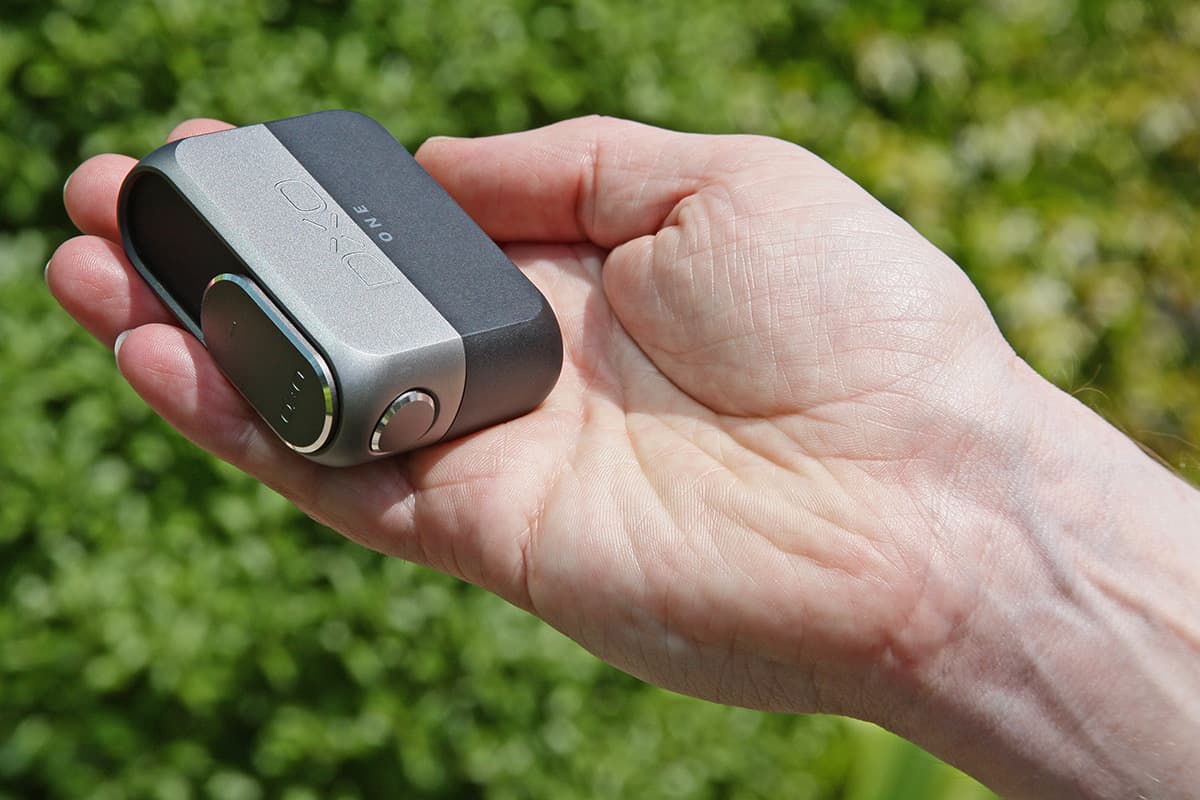
The DxO One is a neat, easily pocketable unit with a large 1″ sensor and fast f/1.8 lens
It’s become something of a cliché that smartphones have decimated the compact camera market, simply due to the fact you always have one with you, and the ease of sharing images. But equally, we’ve got tired of saying that the image quality, while impressive under favourable conditions, can’t match a ‘proper’ camera. This is simply down to size and space constraint – smartphones overwhelmingly use small sensors and lenses (aside from Panasonic’s CM1).
Various approaches have been taken to try to address this. Almost all new cameras these days come with built-in Wi-Fi for easy image sharing, but this is no good if the camera is too large to carry around all day. Sony has produced its ‘lens style’ cameras which connect to a smartphone by Wi-Fi, using it as viewfinder and control unit. These are capable of decent images, and have been widely imitated, but are still quite bulky, ergonomically awkward, and kill your phone’s battery at an alarming rate. Now DxO has come up with another solution – a premium camera module that attaches directly to an iPad or iPhone.
The core specs are impressive enough. The One uses a 1-inch type, 20-million-pixel sensor that’s likely to be same Sony unit as used in premium compacts from Canon, Panasonic and Sony, as well as in the CM1. It’s paired with a bright 11.9mm f/1.7 lens, giving a moderately wide-angle 32mm equivalent view similar to that offered by many smartphone cameras. But crucially it all folds down to a small rectangular box that slips much more easily into a pocket than Sony’s cylindrical QX lens-style cameras.
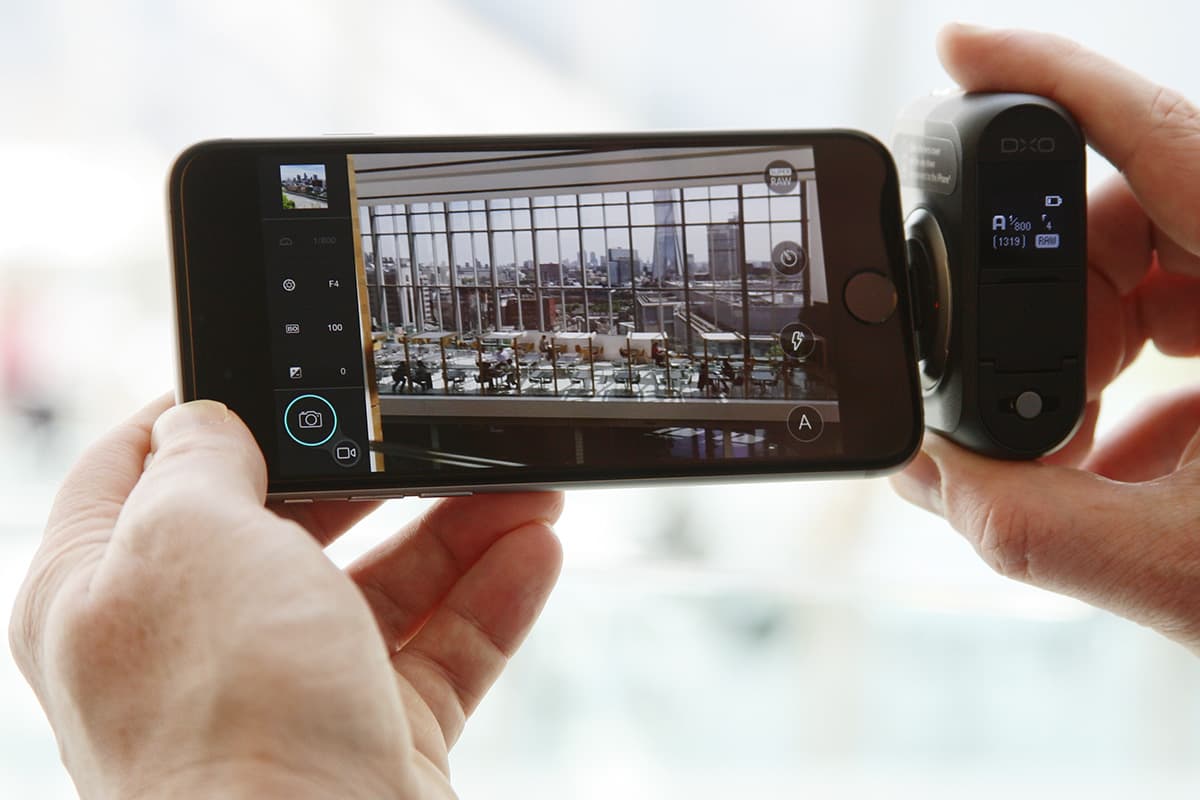
DxO’s control app is neatly designed, with plenty of manual control
The camera is clearly aimed at photography enthusiasts – of only because, at £499, it’s more expensive than some premium compact cameras with fast zoom lenses and 1″ sensors, including the Canon PowerShot G7 X and Sony Cyber-shot DSC-RX100 II. But it comes with requisite levels of manual control via the free DxO One app. Program, aperture priority, shutter priority and full manual exposure modes are available, along with auto, scene and selfie modes. The ISO range covers 100-51,200, shutter speeds run from 15 sec to 1/8000 sec, and the aperture can be set from f/1.7 to f/11 using a real, 6-bladed aperture diaphragm. Images can be saved as JPEGs or raws in either DNG format or DxO’s own proprietary ‘SuperRAW’ format. This can store the data from four exposures, to make a final low-noise multi-shot composite image.
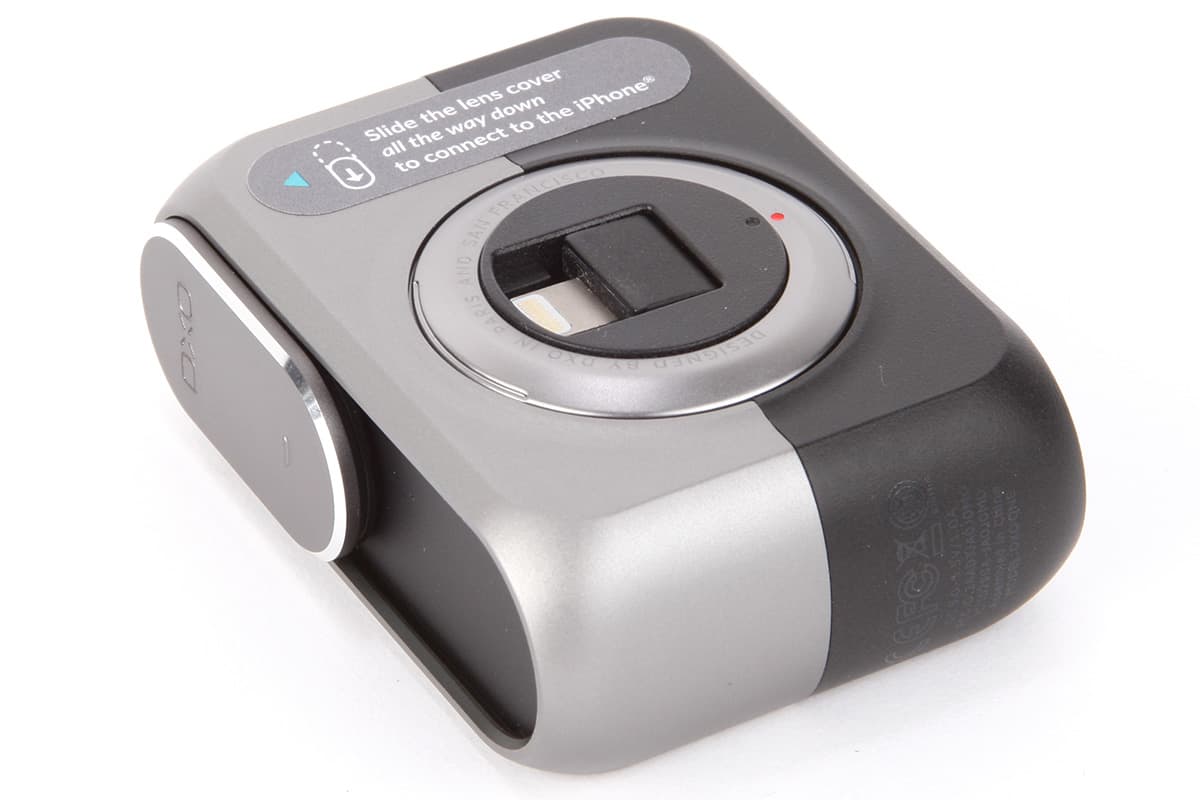
The camera module folds up into a neat, pocketable unit with a folding Lightning connector and sliding cover to protect the lens
Physically the One is an impressively small device that’s shaped as a small box with rounded ends, and less than half the size of even small premium compacts cameras like the G7 X. There’s a sliding cover that protects the lens; pulling it down turns the device on and releases the spring-loaded folded Lightning connector. When the unit is all folded up, it slips easily into a small pocket, and with a solid aluminium body case it feels like it will take a bit of abuse, too. One point worth noting is that there’s no tripod socket.
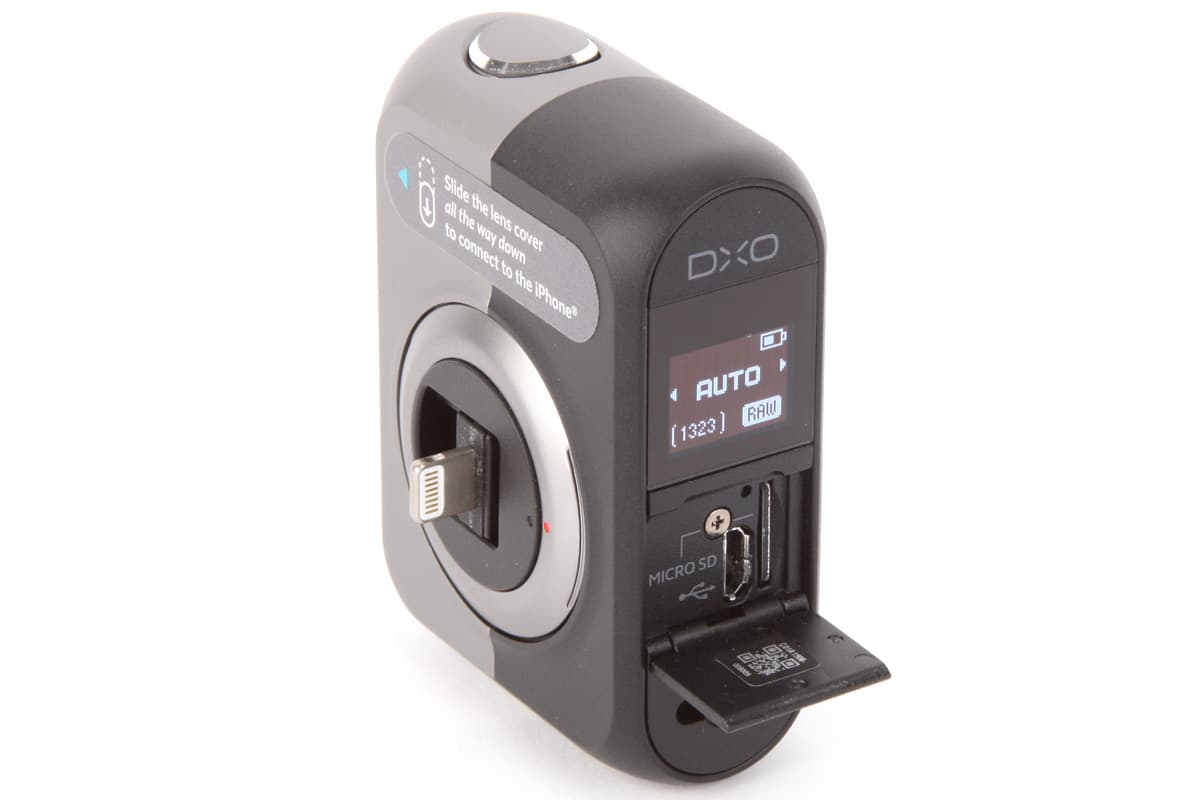
The Lightning connector folds out of the side of the camera unit, and the MicroSD card and Micro USB socket are under a flap on the back
On the top is a conventional two-stage shutter button – half-press to focus, and press fully to take a picture. The back of camera is quite simple, with a small status screen that’s touch sensitive, and can be used to switch between stills and movies when the One is detached from the phone (although at this point you’re literally shooting blind). A hinged cover that folds down to reveal the Micro SD card slot, and the micro USB port that’s used to charge the built-in battery. As yet there’s no information on battery life, but because the One connects to the iPhone physically rather than via Wi-Fi, we’d expect it to be quite respectable.
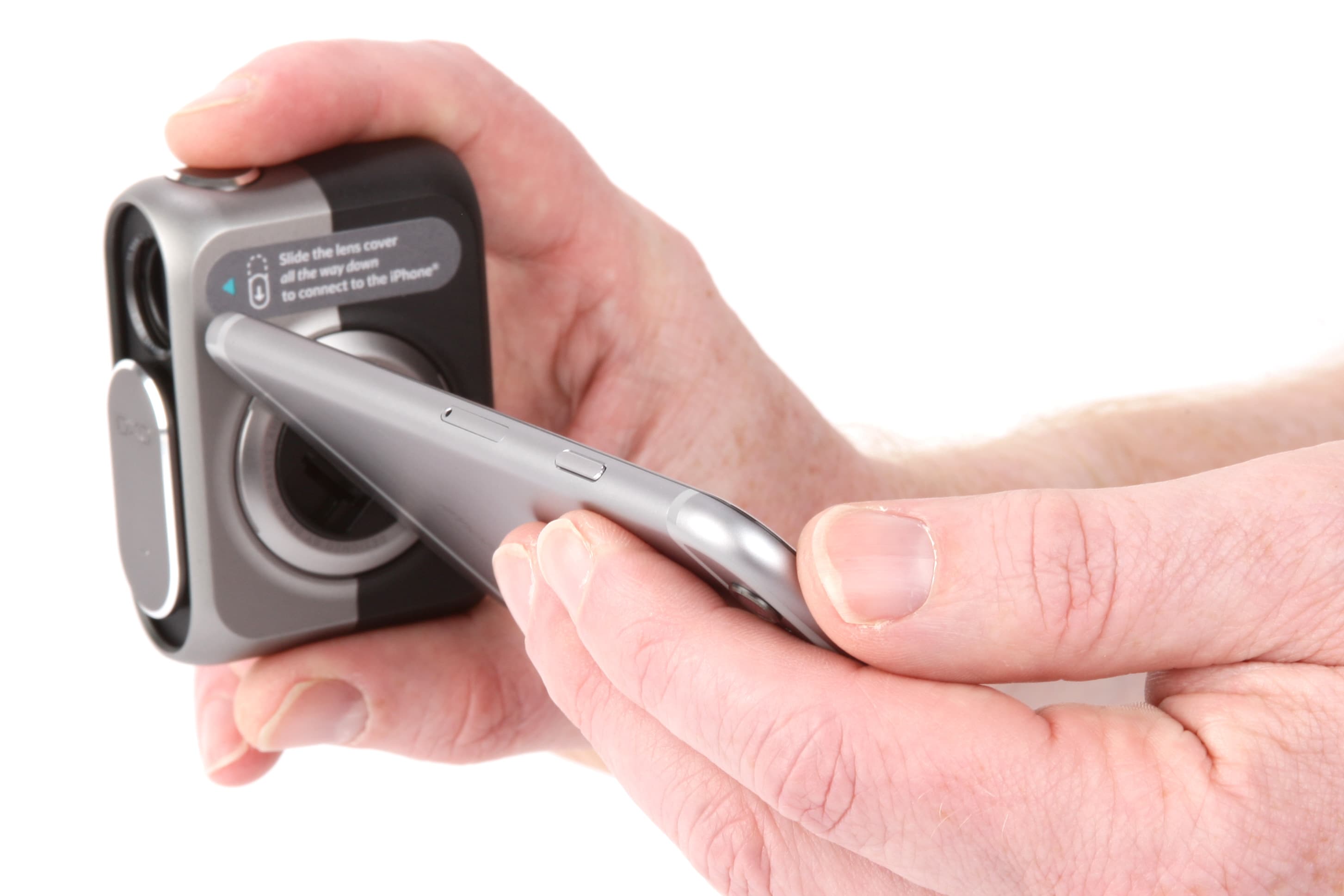
In-hand, the DxO One design works surprisingly well
When you first see the One it’s difficult to envisage how well it will work ergonomically, but my first impression is that the design is quite successful. You hold the camera in one hand, with index finger on the shutter button, and the phone in the other. The joint between the two swivels, allowing plenty of flexibility in shooting angles, and because the Lightning connector is reversible, the camera can be set to face back towards the user for – you’ve guessed it – selfies. Here the app has a trick – when you press the shutter button it lights the screen up orange, with the aim to providing flattering auxiliary illumination in low light conditions.
Overall, I find the One rather better to use than barrel-shaped lens-type cameras that clip on to the front of a phone. But the big question mark lies over how well the Lightning connector will hold up over long-term use.
First impressions

Amateur Photographer Technical Editor Andy Westlake gets to grips with the DxO One
The DxO One is certainly a really interesting device, and my first impressions of it are generally pretty positive. The unit we have is early pre-production, so we can’t say anything yet about image quality, but the design works unexpectedly well, and the app is slick and nicely-designed. Autofocus is impressively quick too.
It may seem odd that DxO is releasing a camera – after all the company is best known to photographers for its software, such as the DxO Optics Pro raw converter. But what’s less well-known is that DxO has serious expertise in mobile imaging hardware and firmware too, and is a supplier to smartphone manufacturers. So the omens are pretty good. We’re really looking forward to putting a full production model through its paces when it arrives in the AP office.







